RV Alaska :: Denali :: Kenai
May 18 - Departing Atlanta

RV. Alaska. Two words that have needed to go together in my life experience. After two and a half or three months of seemingly non-stop planning interrupted only by work, food, sleep, we're finally off to go RV... in Alaska! My father picks us up at 5 pm sharp and then drives us to the airport in the Town & Country. Getting a free ride is a family tradition: it's cheaper than a cab and it saves us a lot on parking on extended trips. Traffic on I-285 is light, but we're not exactly sure of the status of our frequent flyer e-ticket since there was quite a bit of confusion on that over the past three or four weeks every time we called Delta. We assume that we really are confirmed and that we really will be able to get on the flight, but who knows. So my father waits by in the car while we check in at curbside. The neatly coiffed 40ish Delta agent with salt and pepper side burns pulling curb-side duty dutifully tells us that the flight is only half-full, but that he still doesn't have the authority to seat us side by side. In spite of that, he's a really nice guy, courteous and professional. Right now I'm thinking of the hilarious (aren't they all?) Seinfeld episode where Costanza doesn't tip the curbside guy and so his luggage ends up AWOL. I'm a genuinely bad tipper, but with Costanza in mind I tip the man $2. It's 6 pm. We have plenty of time to catch our 720 pm flight. So far, so good.
I find Atlanta's Hartsfield International Airport exhilerating every time I arrive. As far as I know, it is or has recently been the world's premier airport in terminal size, number of gates and number of flights and number of passengers. Not bad for our once small city. I suspect that Hong Kong's new airport is the world's largest in terminal size now. I saw it a few months back and I almost fell over backwards craning my neck up to stare at the high, gracefully arched ceiling. But Atlanta still thrills. Of course, Hartsfield is also an airport done on a tight budget. If I remember correctly the cost of the "new" Hartsfield airport, which was opened in the fall of 1979 cost about $220 million in 1979 dollars. The international terminal was adding before the 1996 Olympics and the T-gates at the main terminal have been extended and I don't know what all of those costs are. The architecture is underwhelming, but the four primary concourses - A, B, C and D (and probably T and E as well) are about half a mile long.
Once we get all the way to gate A-2, 1/4 of a mile down from the transportation corridor at Hartsfield, we find a very different scene from what we are expecting. The seating area is very full. And there is a line at the check in counter. And the Delta agent does seat us together, but seems to do so rather grudgingly and perhaps hurridly, more to get us out of the way than to make us happy, underlying the fact that the line is building up behind us. Still, we board on time, depart on time, and thus inaugurate this non-stop flight from Atlanta to Anchorage, which I figure must be the longest non-stop on Delta's domestic network. A casual look at the map in the in-flight magazine shows that Atlanta to Anchorage is about the same distance as Atlanta to Paris: yet we'll be leaving the US and also arriving in the US. The Russians probably have a longer Moscow to Vladivostok domestic flight on some decrepit Illyushin widebody, but this must be just about the longest domestic non-stop flight in the world.
We fly north as the Georgia pine covered rolling hills turn into the slightly larger Appalachian Mountains - the world's oldest and thus perhaps the most worn down. The Appalachians continue in Tennessee (and North Carolina, though I suspect we are only flying over Tennessee today) and then flatten out not too long after. "Miss Congeniality" is the in-flight movie. This Sandra Bullock vehicle doesn't live up to its name as a movie even though she does. Take her out and the movie is completely pointless, but the studios must think "who cares - she's fun to look at" and they would be right. I watch it anyway to kill time. Forget the movie, my brain checks back in to remind me that the real show is the scenery, spectacular off to the right of the aircraft, which is our view. Soon the scenery turns to roads that impose their perfect oversized grid pattern relentlessly over Iowa and Minnesota and all of the other states that we never seem to get to visit that are on our flight path. This same path will take us further north up to Canada over Winnipeg where I spent most of my first four years of life - before the scenery goes breath-takingly still. There is no in-flight monitor to show us where we are going, but I assume that we are in Canada once the numerous lakes turns into numbers that I can no longer count. The lakes are small and often even parallel, running generally north-south or almost north-south, indicating their ice age origins. Lakes turn slowly into hills and then into mountains. I am familiar with them though, having been completely mesmerized several months earlier on the non-stop flight from Atlanta to Tokyo which flew pretty much the same route. The sky, which had been getting darker as the sun dipped toward the horizon now seems to have reversed itself and risen a little bit. I'm not sure if it's an illusion, but it seems possible since we were definitely headed north, but have now started to turn west. The hills that I don't remember really noticing have all of a sudden started turning into giant snow-capped mountains and then we see glaciers and small frozen mountain streams. At least they look small from here... I have these fantasies of skiing down there and I'm not even a good skier. And I assume that we are now over the Yukon and later just in Alaska, perhaps over the Wrangell/St. Elias National Park. Wrangell/St. Elias is our nation's largest national park with an astounding 12 million acres meaning it's larger than Switzerland (and with mountains significantly higher than the Swiss Alps to boot). And I found out later by looking at a map that I was correct in thinking so. I flew over Alaska back in November on the way to Tokyo (and ultimately Singapore and Taiwan) and haven't been able to wait to actually come to Alaska and be on the ground here. Wrangell/St. Elias National Park also packs nine of the nation's 15 tallest peaks, though Denali National Park has the tallest one which is Mount McKinley.
Though the meal is terrible (i.e. great by Delta standards) and the second movie another forgettable snoozer, the flight is fine. At least Delta showed us two flights to kill the time. Our Delta 767 has a full complement of magazines and blankets and pillows that compensate for seating designed for legless pygmies. And at least the tickets were free, as they should have been after about 13 years of accumulating frequent flyer points that I have never used until last year when I flew to Billings, MT. for our Yellowstone trip. As we start our descent, the pilot comes on the PA and tells us that Mt. McKinley should be visible off to the right. He's not kidding. Though the entrance to the psuedo-eponymous park is 240 miles away from Anchorage by road, we see McKinley and a smaller mirror image off to the left of it off in the distance our of the right side of the aircraft right at our 3 o'clock. It's huge and appears to tower above the clouds that look like they're only coming up to its waist. If I didn't know better, I would guess that it was 20 to 40 miles away. I still haven't figured out how a 20,000-foot high mountain can appear to be so close. It's completely white at this distance, and looks like a protrusion of the clouds more than something that is of a completely different material. We are able to keep our eyes on the mountain for about five minutes until we drop through the last layer of clouds and everything shows hues of orange of the setting sun. A few minutes later, after a shot over blue open water, we touch down. And we even arrive early in Anchorage. Alaska. After all these years, Alaska!
May 18 - Anchorage at Last
It's 11 pm. It's still light out, but barely. The daylight hours will peak during late June. Few cities are named as functionally as this one: Anchorage. The founders were to the point. And they nailed it in one word. So it's a bit hard to spell when you're a kid. Other than that, it works. It's a port with a good harbor. I can't imagine Washington being named "Capital". What would a functional name for Seattle be? "City of Harbors and Rain and Coffee and Software"? See, the one word name thing is pretty hard to come up with. The city glimmers in gold, as edges of the small steel and glass buildings catch the low rays of sunlight. The tallest building must be about 18 stories high. There is nothing about Anchorage that looks exceptional. I mean take this city away from the water and the mountains and it could be Lubbock, Texas. And yet the city sits majestically on its throne of ocean and mountain views. For now Anchorage gets about 18 hours of daylight per day. The sky and the mountains are pink, reflecting the last light from the already set sun which we had seen setting on our final approach. "For those of you who missed it from the left side of the aircraft," the pilot announces as we taxi about, "you'll see Mt. McKinley now as we turn around on our way to the gate." The Athabascan name for the mountain is Denali. The park all around it is Denali National Park and is one of our main objectives. I still can't figure out how we could see if from 10,000 feet. Now I'm even more dumfounded that we can see it from the ground: I thought that we can't see more than about 35 miles while we're on the ground. Sure enough, there it is, though not as visible as before. It doesn't matter; the airport appears to be flanked by quite a few other snow-capped mountains just a few miles away. It's very majestic, distant and yet approachable at the same time. The weather is in the 40s, but feels warmer. The highs during the next few days should hit 60 degrees Fahrenheit.
The airport looks like it might have been built during WWII and then slowly upgraded in bits and pieces. In fact, it probably was since Alaska was probably an infrastructural backwater under World War II and the threat of Japanese invasion spurned the Al-Can Highway that zips up from the lower 48 states through Canada into Alaska. The current complex looks like it was last updated in the late 1970s. The first thing that we notice is that there are a lot of Native Americans (Inuit) people here, which is wonderful. It's nice to see that we were good enough to let some of the natives survive. Small groups of arriving passengers are immediately swarmed by double their number of their greeting parties. Everyone is very happy! From the gate to baggage claim takes a few minutes. There is no real tourist information other than some of the brochures lined up against a wall. I travel with lots of nagging fears trailing me: I wasn't planning to bring tourist information since I like ditching extra weight. But those nagging fears made me put the brochures and books in our luggage. I'm glad I brought what I did, but obviously I didn't bring enough. I worry for a moment, then figure that we'll manage. We take a cab from the airport. The man who helps is hail a cab is one of the cab drivers who is waiting for someone else, apparently, since he is at the head of the line, but keeps talking to his dispatcher, trying to get some vital piece of information. He's another kind of Indian: south Indian. :) [NOTE: Why didn't these emoticons make their appearance before computers or in fine literature? They certainly are handy!]
The second thing that we notice is that even though it's past 11 pm, I'm not uncomfortable in a yellow polo shirt, khakis and buck shoes. So it can't be too much below 60 degrees. This isn't quite the Alaska that I was expecting.
Everyone is from out of town, including those who are from in town. Our cab driver is a loquacious Nick Nolte-ish man from Detroit. "I've been here 20 years, and I never went back. I go down to visit every once in a while..." he says referring to either Detroit or to the Lower 48 in general. We will end up hearing quite a bit of this kind of sentiment from others in Alaska. People just seem to get stuck here. Scratch that. Sounds negative. They seem to become totally captivated by the majestic beauty of this rugged state.
He takes us to the Sweet Retreat RV Rentals a few miles off of the highway, chatting the whole way. Sweet Retreat is giving us a great rate of $90 per night plus an 8% tax; that's the May Special ($90 instead of $135 per night plus free unlimited mileage) and we avoid having to pay the 10% airport tax since it's several miles away from the airport. We booked everything a while back via e-mail and telephone from Atlanta and have made prior arrangements with our sales agent Marcela. She and the gang at Sweet Retreat will leave the key for us inside the external hot water heater maintenance compartment since they close at 5 pm. Apparently this is rather commonplace since they already have instructions typed up which they faxed over to us when we confirmed the reservation. Which makes me wonder why a lot of other people don't just go by RVs that are parked outside of RV rental lots. Maybe that's what smart homeless Alaskans do.
Still, we ask Nick Nolte to stick around while we try to find the external hot water heater maintenance compartment and while we try to use the door key to get into the RV. Sounds silly, but we've never RVed, have no idea what we are doing and really don't know where the hot water heater maintenance compartment is. There are lots of rounded rectangle doors measuring from a few inches (for gas and for water) up to a few feet - such as the large luggage storage compartments along the flanks. The door key works after a little experimentation, and we're finally in. Nick drives off after we thank him and tip him profusely. The first thing that we're struck with is that even though this 24 footer is a "little" RV in Alaska, it's much wider than we expected. I can't figure out how it's ever going to fit in a lane on the road, or how I'm going to ever get it around a corner. The length is about right though. Inside we have everything that we would ever need including a microwave, a table that turns into a bed, two other beds that are queen size, a toilet, a shower, two sinks (one for the kitchen and one for the bathroom), 11 windows, at least 20 compartments like the kitchen cabinets and clothes storage closets to the little door pockets, an oven, a microwave, a closet, a fridge with a freezer, curtains all around, etc. We can immediately see how we will be at home here for the next few days.
We soon figure out that the electricity only runs when the RV is off. Well, you could run it while the RV is running, but chances are that one is not using the microwave while driving. The electricity runs from a generator or if you are hooked up, from a land line. Water is stored on board in an 80 liter tank (normally). It serves the kitchen sink, bathroom sink, shower, commode. The first two feed the gray water tank and the latter two the black water tank. You have to hit a "dump station" (easily available in places like Alaska, perhaps not quite so in less RV frequented places like Georgia) to dump water and replenish. The electrical generator powers all on-board appliances other than electrical stuff that would be used to operate the vehicle as a vehicle (windows, dash, etc.) which are powered from the vehicle's "car" battery.
There are two other RVs parked immediately behind ours with gaps of about 10 feet in between each. All of them are parked outside of a one acre or so compound that is chock full of RVs. For now we are the only ones. But during the night, at around three a.m., we hear another family arrive at the one right behind us. And then yet another family arrives and gets in to the RV at the end of our line. Maybe Nick dropped them off too?
May 19 - Saturday morning in Anchorage
I'm excited! It never seems to get completely dark. We keep checking her watch throughout the night since I don't have one that works and that fits on my wrist. I have a wonderful gift watch from my cousin, uncle and aunt in San Jose that I still haven't resized to get the extra links removed. At 2 am, we check the watch. At 4 am, we check again. It's bright outside, but it's only 4 am. We keep falling back asleep and waking up afraid that we'll oversleep. Then at around 6 am, construction starts and there is a dog that barks so incessantly and with such methodical and regular cadence that I wonder if it's just a noise maker or an ultra-sophisticated and realistic alarm system. But later I learn that it's a real dog.
Sweet Retreat RV Rentals opens at 9 am. We and the two other families that arrived after us in the middle of the night are all there waiting for the doors to open so that we can officially check in and hit the road. They're all veterans, for they check in and are out the door within half an hour. We take the same amount of time to check in, but then require another hour or more to watch the orientation video (with quite a few little rewinds in between) and then ask our English mechanic/orientation expert a zillion questions confirming that we are indeed "newbies" to the world of RVing. He's dressed in a clean blue one piece mechanic's overalls with a matching cap covering his shoulder length hair. "Are you from York?" I query, based on his midlands British accent. "No," he replies, "I'm from England". Hopefully he thought I asked him if he was from New York, or he understood me correctly. In the former, I must have looked like an idiot. If it was the latter, then I need to watch the news more often for York has probably succeeded from England. In either case, it turns out he's from England somewhere north of London. He brushes a strand of sandy-blond hair out of his eyes. "I came over in 1981, and never went back." He reminds me a little bit of Monty Python's Eric Idle, and I expect him to make me laugh... But he doesn't. He's just matter of fact the way someone is who just loves their work.
We head out, slowly, nervously, hoping not to run over anything small, like a Cadillac, and hoping not to burst the tires on the curb during turns that seem to pop up every block or so. I've never driven anything larger than a mini-van. My daily driver is a four door sports sedan. So for me, this thing is huge. My mirrors appear to reach well over into the other lane. I can't even see what is on either side of us other than by trusting the mirror. Yikes, that is something else. The old glance-over-the-shoulder trick proves impossible since there is a wall where I would like to have a window. We don't get far before stopping at K-Mart where we go to requisition some basics, like thermal socks. There are RVs everywhere. Supposedly Wal-Marts and K-Marts welcome RVs overnight. All the parking lots around here have RV size parking spaces. At the K-Mart, there is an ad-hoc used RV sale lot with maybe 30 or 40 RVs starting at about $15,000 and going up to five times that. Most appear to be in great condition, so naturally we wonder how many people make about one big trip in their RV and then never do it again. We've only been in our RV for a few hours, but we drive through this lot slowly looking at the prices to plan for the future: the temptation to buy is great, but maybe we had better see how this goes first. Then we go to the other great Mart: Wal-Mart. So far, we've come to Alaska only to spend a couple of hours shopping, albeit shopping surrounded by beautiful snow capped mountains. I run into Wal-Mart to look for one of those cheap watches that tells the temperature and has a compass. Through the course of our trip I will learn that neither is effective. We are starting to learn that RVers belong to a cult that looks out for other RVers and helps them at every turn. We head back to K-Mart again to pick up a $40 tripod that I had eyed a little before.
We're still in Anchorage, but we start to head south. There are no Interstate Highways in Alaska because (and this is obvious in retrospect), there are no states next to Alaska to connect to. We make our way to the highway to drive south toward Seward, but pull off still inside of Anchorage after one or two exits because we see the sign for Carr's Groceries. This store is, I guess, the most important grocer in Alaska. Everyone at Sweet Retreat RV told us to go there. And people at the various Marts have mentioned it as well. As I add in some more details to this travelogue three months later, I realize that I have forgotten the name of the most popular gas station, one that I had never heard of, but, if memory serves correctly, is called Tesoro.
At Carr's Groceries, the gentleman behind the fish counter comes by and says jovially, "Hope you're having a great day!" He has that universal butcher's look: well fed and extremely friendly, except that he's younger than I am, and younger than the average butcher that one typically runs into. I am having a great day, I tell him, and wish him much the same. Everyone is so nice in this state! The cashier tells me that he's originally from California, but has been here since 1991 and is never going back. He looks Latino. Alaska is pretty diverse except that I see very few African Americans or people of Asian descent (other than the ones that came over during the various ice ages). Over and over, we hear the same typically friendly greetings. Inside the store and everywhere else so far in Alaska, it seems like everyone is very social and very cheerful. The men are either under 25 or over 55: there is no middle ground. I suppose they are working all the hard jobs - drilling for oil or out doing all of that commercial fishing. In either case, the men who are here usually sport facial hair. The young ones have a three day old five o'clock shadow; the older ones, with their white beards, gold miner clothing and middle age paunches just look like they've been training for an Earnest Hemingway look-alike contest and won hands down. We've been reading that the ratio of men to women is something like 10:1 making this about the best place in the world outside of a military camp to be a single woman, but that doesn't appear to be the case here. And everyone here is incredibly nice. The women all have very all-American looks accentuated by a conspicuous absence of makeup and glamour. Everyone dresses in a practical and casual Wal-Mart style that makes me very much at home. It's as if everyone here is ready to go outdoors at a moment's notice. The absence of glamour is very much evident in other ways as well. There is none of the conspicuous consumption that is such an intrinsic part of life in Atlanta. I see two BMWs, one Jaguar, and one Porsche. All are used to the point of being past generation car styles. There are very few imports as well. RVs are almost as common here as SUVs are in Atlanta. The homes are modest, which is probably a function of the cost of everything in Alaska. My guess, based on a 1.5 liter of Woodbridge Cabernet Sauvignon at $18 is that everything costs about 50% more than back at home. Our taxi driver last night told us that his "tar shack" was worth $150,000. We stock up enough to fill the fridge with meats and veggies, the freezer and several of the cabinets with dry goods like cereal and whole wheat bread. We even get ice cream. Ironic: come to Alaska and eat ice cream. There are these beautiful Alaskan sweatshirts and they are even on sale. For whatever reason, we didn't buy them. As soon as we head out of town, we decide that we should have gotten them.
May 19 - Saturday afternoon to Seward
The facts about Alaska are astounding and really hard to take in. But they have been one by one, revealing themselves as epiphanies rather than true contemplative thought. Alaska is too big to be visited in one trip. Our US maps show Alaska squirreled away in the bottom left corner, a smallish place somewhere north of Hawaii and south west of California. Looks like it's about the 10th biggest state or something. But, of course, it is by far our largest state. Texas, our second largest, could fit in Alaska two and a half times. That's like the difference between a middle income home and a mansion. Or a 747 to a 737. Or a pro-team to minor league team. It really is that different in size. It's hard to think of it all as one place, but yet there it is - a single state under one name. Take a look at an equal area projection map, one of those that doesn't overexaggerate the size of the polar regions including Alaska, but that doesn't underemphasize them either. If Alaska were to be superimposed over the Lower 48 states, it would reach all four sides. That's right: from Attu Island on the western end of the Aleutian Islands to Ketchikan in the south east, it's about as wide as going from LA to New York. Or London to Baghdad. And as tall as from Minneapolis to Miami or so. Alaska is bigger than Mexico. And about the size of all of Western Europe combined. Alaska has five time zones and reaches west to the international date line. Alaska is the northernmost, easternmost and westernmost part of the United States. So how does one plan a trip to cover Alaska? In a week and a half of travel time? One doesn't. Hit one section and have fun getting in as much as possible there and then return as often as possible.
Alaska only became a state in 1959. That means a few years after Elvis had become a mega star. That's pretty recent in my book as far as historical events go. It was the second to last state to enter the Union, just before Hawaii.
Attu and the adjacent island of Kiska have the distinction of being the only part of the US invaded during World War II. Attu was invaded on June 6, 1942, exactly two years to the day that we invaded Normandy, France.
Anchorage is the biggest city with a population of 250,000 or so. According to our Rand McNally US Road Atlas, the total population of Alaska is about 550,000. Under a million. There are 570,000 square miles, so that's about a person per square mile. Imagine that population density applied to, say, New York City. I don't know what the square mileage of NYC is, and the pay for writing this article is too low to afford a fact-checker, but I suppose that it must be somewhere in between 25 to 250 square miles, in which case NYC on Alaska density would have a population of about 25 to 250. Actually the same Rand McNally US Road Atlas cites 47,224 square miles for New York State (as opposed to just the city) and a population of 18,000,000 for the state. So that's about 380 per square mile for the entire state. So New York State is about 300 times as dense as Alaska. And New York state's population on such a scale would be go from 18,000,000 to about 47,500.
The place has had three of the six largest earthquakes ever on record and is techtonically very active. Alaska has something like 12 percent of all of the world's earthquakes. The 1964 earthquake was a 9.4 on the Richter scale!
We don't spend too much time sight seeing on our drive, unless we count the two and a half hour drive along the Cook Inlet down to Seward that is all beauty. Actually we did pull off at one place along the Turnagain Arm of the Cook Inlet in hopes that we might see whales blasting out of the water. No such luck, but the spot was beautiful and very windy. A lot of other people felt the same way since the place was packed by Alaskan standards. It takes me a couple of more hours before we realize that "Turnagain" is not some kind of bird and that it should be pronounced "Turn again" instead of "Turn-ah-jee-an".
Our planned itinerary is convenient that it is almost all multiples of 60 road miles. In fact, I wish I had thought of calling this Alaskan Units - AUs - while we were there. Anchorage to Seward is 120 miles. Seward to Homer is 180 miles. Homer to Anchorage is 240 miles. And Anchorage to Denali is 240 miles which we will be doing twice driving up there and then back to Anchorage on the last few days of our trip. Actually the miles for each of these varies a bit, but these numbers are close enough and easy to remember and in AUs means that our trip will be 2-3-4-4-4. However, these mileages don't bear out to consistent driving times because of the differences in the quality and speed limits on the roads.
I keep thinking that Seward is a funny name. Seward. I hear it echo back and forth in my head. But the town was named after William Seward, the US Secretary of State who arranged for the purchase of Alaska from the Russians at about two cents an acre in 1867. What a bargain!
The wonderful place that we finally find at the southern end of Seward is the municipal campground where we will end up camping for two nights. There are tent spots and RV spots. We are in a medium-size parking lot marked out for RVs. Our "campsite" is quite a room with a view. We have Resurection Bay - basically the ocean reaching into deep into the fjord which leads to Seward - on two sides, town of Seward on one side, and mountains all around including behind Seward and all around Resurection Bay. Each mountain is snow capped with protrusions of brown indicating rock or wooden patches. The transitions from one color to the next are abrupt. The tree line interrupts the white flanks at about 2,000 feet, which is half way down. The rest of each is a thick forest temporarily shod of foliage. At this moment, we are all of 12 feet from the lapping water and perhaps less than that above it.
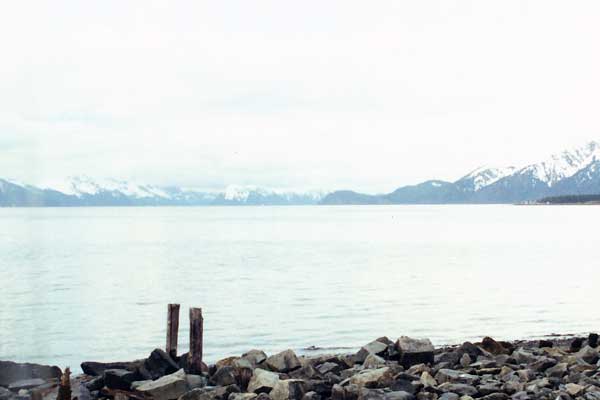 There is a thick border of stones and pylons of a pier that gets submerged as the evening progresses. It will reveal itself to us again tomorrow morning. We also notice that many of the "stones" are in fact torn up tarmac. Perhaps this was a parking lot or something long ago that was somehow torn up by the great '64 earthquake that was the most horrific recorded on North American soil. Or perhaps not. I can only speculate... (Note: It isn't until we get back to Atlanta that I realize that we were right next to the Idatarod Trailhead Park.)
There is a thick border of stones and pylons of a pier that gets submerged as the evening progresses. It will reveal itself to us again tomorrow morning. We also notice that many of the "stones" are in fact torn up tarmac. Perhaps this was a parking lot or something long ago that was somehow torn up by the great '64 earthquake that was the most horrific recorded on North American soil. Or perhaps not. I can only speculate... (Note: It isn't until we get back to Atlanta that I realize that we were right next to the Idatarod Trailhead Park.)
The RV is kitted out with a full set of cooking and eating ware - pots and pans, glasses, forks and knives and plates, etc. So we didn't have to buy any of that. I settle down at the table with this laptop to start writing more of what is above. And this line. And some of what is below. The clouds are dark looking south down the long neck of Ressurection Bay - the fiord that leads to the ocean. It's not a classic steep wall cliff fjiord like the Norwegian ones. It's more of steep sloped mountains rising straight out of the ocean climbing rapidly several thousand feet to their snow capped peaks. Normally I love trees, but in this case, there aren't any next to us, so all of the views are completely unobstructed other than in back where two other RVs have tucked into place. And even they don't block much of it. It's quite a lot to take in and marvel at. I have never had a room with a view like this one. We see the mountains in all four directions - through the back window where the main bedroom is located, through the driver's side long flank windows next to the dinning room where I am sitting right now as well as on the other side, by the entrance into the RV and finally out of the driving compartment in front. The clouds have been playing with the sun all day, but now it has become more and more overcast for the past bit. I'm not sure exactly when the changeover happened. But it has been looking like it might rain some time soon for a bit now. And ten or fifteen minutes later, while dinner is still in the works, we hear first the brush of sprinkles followed by the light drumming of rain all over the metal work of the RV. And so we have our first real meal in Alaska, surrounded by mountains, right up against the ocean, and serenaded by the rain... We are at the seemingly impossible junction of an exotic destination surrounded by the comforts of being in the US and in a warm and secure home on wheels.
Sunday, May 20 - Seward
 We awake up with the early presence of overcast daylight that breaks gently over the waves and mountains that surround us here in Seward. It is just past six am. To be honest, I can't verify that it ever got dark last night because we feel asleep after a bountiful feast reaped from three or four hours of shopping in several different places. She started us off with some fresh vegetables and some dip made of French onion soup mix mixed in with low fat sour creme. And some caviar - the cheap black kind that comes in a little jar which suits the people like me just fine.
We awake up with the early presence of overcast daylight that breaks gently over the waves and mountains that surround us here in Seward. It is just past six am. To be honest, I can't verify that it ever got dark last night because we feel asleep after a bountiful feast reaped from three or four hours of shopping in several different places. She started us off with some fresh vegetables and some dip made of French onion soup mix mixed in with low fat sour creme. And some caviar - the cheap black kind that comes in a little jar which suits the people like me just fine.
After that it was off to bed...
Today was the day that we took the eight hour cruise to Kenai Fiords National Park. I heard the theme from Gilligan's Island repeating in my head. I wanted to turn it off, but it kept going and I knew that the only way to get it to stop was to get something even worse like more or less any Phil Collins song - especially that silly "One more night..." song. We puttered out of the harbor seeing our RV parked to our side as we went by.
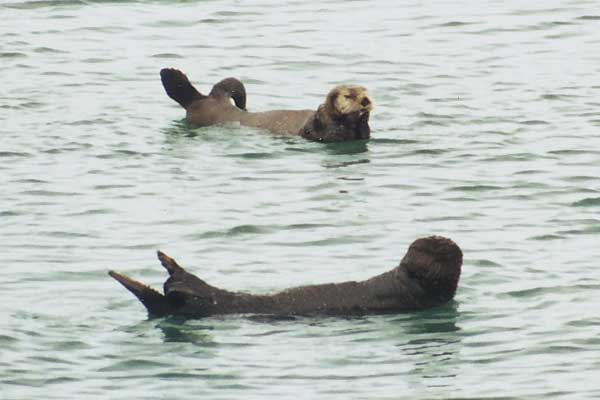
A couple of seals were floating on their backs, and seemed to be watching us as intently as we were watching them. The water must be just above freezing temperature, but their thick coats protect them just fine. I suppose that seals in general have lost a lot of ground to humans, but these particular seals were thriving, feeding on all left over fish parts dumped into Seward's harbor by commercial fishermen. The harbor itself is beautiful, chock fill of several piers full of elegant and well maintained fishing boats and pleasure craft. No big yachts, but there is a large cruise ship on one end of the port. 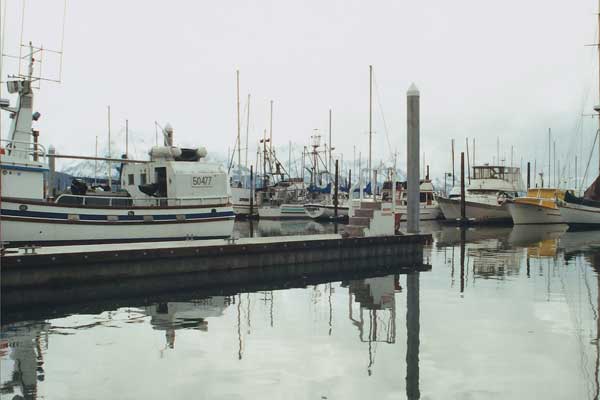
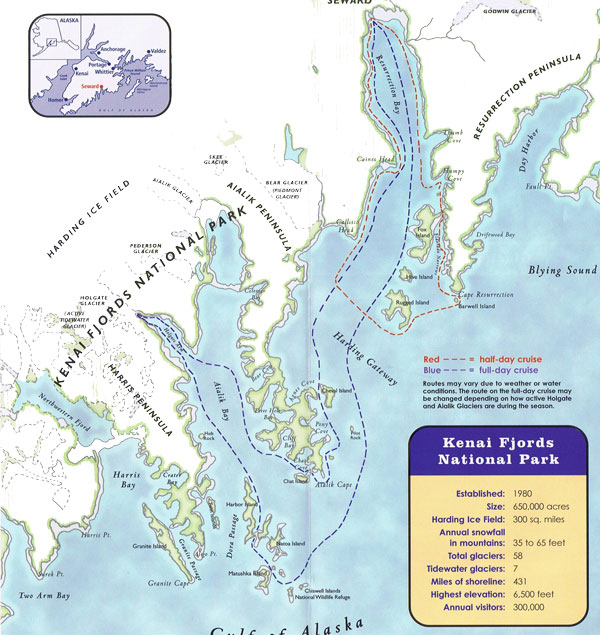
The sky was overcast. And that should have been a warning. But we only had a limited time allocated for Seward, including the day we arrived which was yesterday, so it was more or less now or never since we were due to leave tomorrow. The ship started pitching up and down at the bow and conversely at the stern. At first it wasn't too bad, but the further we got away from Seward and out of Resurrection Bay, the worse it got. The clouds turned from a slightly dark white gray to a much darker, but not black, gray. The cruise turned into a disaster with very, very choppy waves and a lunch buffet that was much less than we expected.
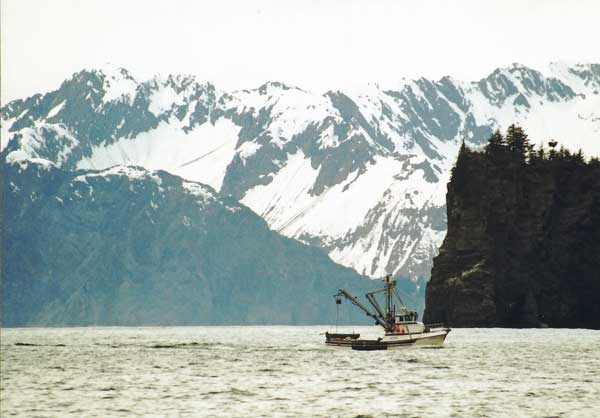 The scenery was spectacular, however. There were glaciers reaching into the sea, magnificent trees growing magically out of the sides of sharp hills, rocky crags full of seals and sea gulls and much more.
The scenery was spectacular, however. There were glaciers reaching into the sea, magnificent trees growing magically out of the sides of sharp hills, rocky crags full of seals and sea gulls and much more.
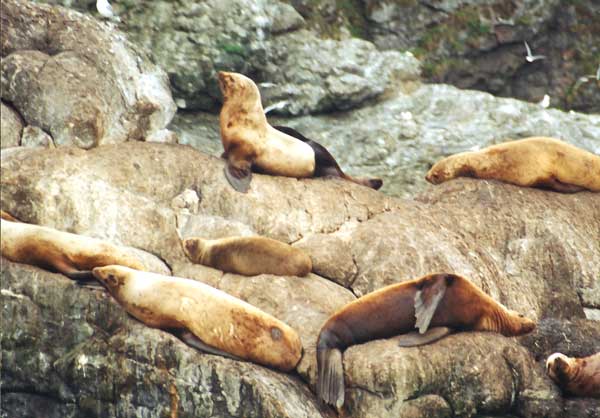 The eight hour trip was cut short down to six hours as we headed back in to beat the storm that was coming upon us. The skipper probably headed back into Resurrection Bay at normal speeds, but to us it felt fast. The enjoyment we had had by being outside was quickly tempered by thick, cold raindrops smacking us and the windows of our vessel.
The eight hour trip was cut short down to six hours as we headed back in to beat the storm that was coming upon us. The skipper probably headed back into Resurrection Bay at normal speeds, but to us it felt fast. The enjoyment we had had by being outside was quickly tempered by thick, cold raindrops smacking us and the windows of our vessel.
The best part was at the end, once we returned to land, when we got to watch a seal (we named him "Fluffy" for some reason which we found marvelously funny at the time) play with his food for about 20 minutes. He would let it start to sink for a few moments, and then dive down to get it. He would disappear for 30 seconds, and then reappear with a huge burst 10 feet from where we last saw him, and then would fling what was left of the huge fish carcass in the air, and keep playing with it.
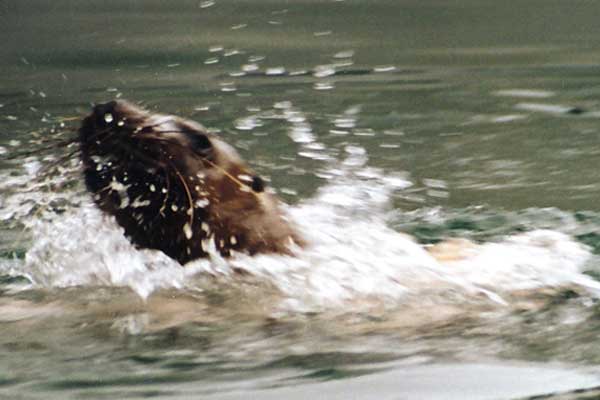
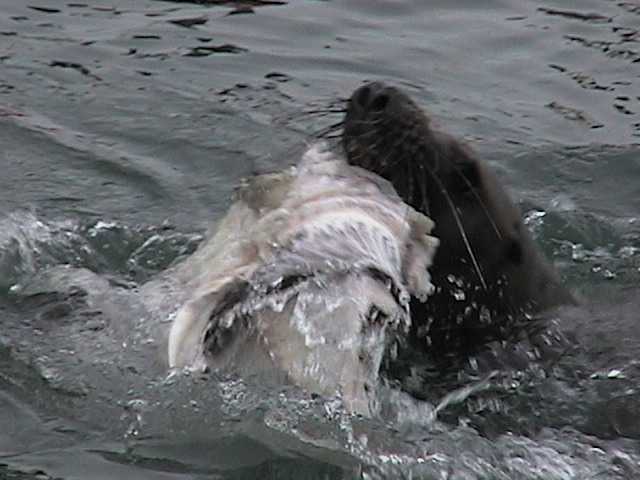
May 21
We awake again to muted daylight. In fact, as we take our sweet time to get ready, we notice that the mist is slowly claiming the mountains in the background so that we can barely make them out. And overhead the clouds have started to take on a slightly ominous black color. We finally slip out of our wonderful campsite at about 10:30 am. So far we've done pretty much nothing other than relax.
We do another sewage and water dump and also take on potable water. A couple from Rhode Island is also at the dump station doing the same thing. Turns out that they were on the same flight that we were from Atlanta to Anchorage the other night. While we have driven just a few hours over the past two days, they have already been from Anchorage to Denali to Anchorage and now to Seward. So they've driven probably at least 12 hours in the past two days. They're here in Seward to go kayaking, something that I wished that we had done. We warn them not to take the eight-hour cruise without checking the weather first, and then we push off. The odometer is on 137.
We head north out of Seward on Alaska 9. It's the only way in by road, and it's the only way out. The "crowds" have thinned out. There are only a few RVs compared to what must have been close to 50 the day before.
We pass the harbor again off to the right and then bid adieu to Seward.
It's almost easy to miss important signs with all of the spectacular scenery all around with all of the snow capped peaks reaching into the clouds. But we do see the one that we need: Exit Glacier. We exit to the left and drive about five miles. The snow-capped peaks accompany us off to the left, but they are even more immediate than before because of there are no traces of human existence between them and us.
We drive all the way through the Kenai Peninsula. The beautiful mountain scenery turns, slowly and almost abruptly at once, into flat tundra. The tundra looks rather inhospitable. I wouldn't want to break down out here at night or when it's cold. I suppose that it could be hours before being rescued. And this scenery is endless, running on for an hour or two. I just want a place to pull off for the night...
We pass through Soldatna and see signs for Kenai. We continue south along the western edge of the Kenai Peninsula. We are now along the Cook Inlet - a curved index-finger shaped body of water that must be 180 miles or so long, and that points to Anchorage and ends there. There are the peaks of what I first think is Katmai National Park off to our right. I just saw a very interesting documentary not too long ago about the volcanic activity of the 1910s that wreaked havoc on what has become the park. All the conical mountains continuously remind us that volcanoes formed this area and that we are on the Pacific Rim. Later I realized that we were actually right across from Lake Clark National Park and Preserve. The peaks were those of the Chigmit Mountains and included both Iliamna Volcano and Redoubt Volcano, both of which are just above 10,000 feet. They don't look all that far away, but the Cook Inlet is about 25-30 miles wide right in front of us, and looking at the map, it would appear that while they appear to jut straight out of the water, that they are actually another 15 miles or more away.
Finally, we are driving lower and closer to the water. We pass many different RV parks, but we can't find one with a kind of view that we would like, though we see on the map that there should be one right on the water. And then we find it: Ninilchik State Recreation Area. There is a short steep road that leads down from Alaska Highway 1 to the beach. Just driving around the RV lot, we see masses of golden eagles. We see 15 or so clustered together right by the water when we get to the far end of the campground. We even see some bald eagles too.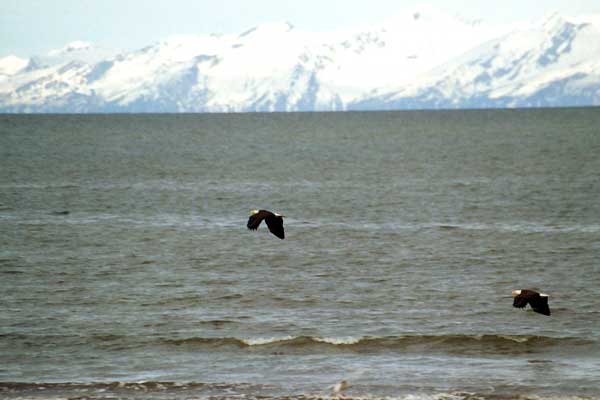
In fact, I've never seen so many eagles in my life. It's amazing.
Tuesday, May 22
The next morning, I stalk golden and bald eagles. The water has run off of the beach, and much of it is exposed. It is rocky, and still very wet... Huge, dead fish, or just their carcasses and their entrails lie picked to the bone by all of the eagles, seagulls, and crows which must come here for a morning feast every morning. The shallowness of the beach must leave all of these large fish stranded. I'm guessing that the fish weigh 10 pounds or so on average before they get picked apart.
I spend twenty minutes to get within 15 feet of a bald eagle and take a photo that fills my frame. He sits majestically on a boulder that protrudes two and half, perhaps three, feet from the tidal beach. He looks at me, contemptuously, and then shortly thereafter, flies off skirting the beach along with several other birds that zoom off to the south. 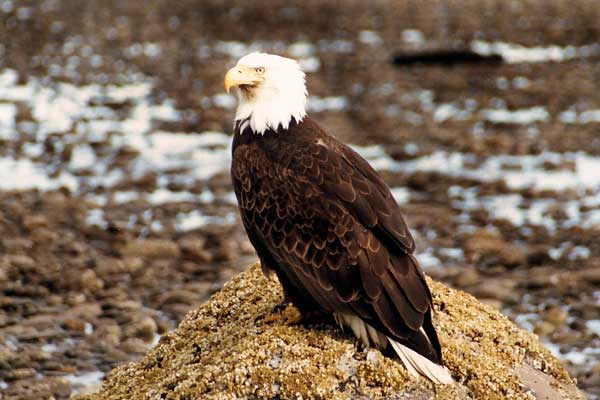
Then we were off to Homer. The view from the Homer Spit was spectacular. The narrow penninsular spit itself is a fun tourist trap stuck in the 1970s or so that time seems to have forgotten. The approach into the spit is fun. Starting with the downhill approach from Ninilchik, we could see for miles as we were approaching Homer. And we could see the signature spit extending several 4.5 miles long away from the town.
Google Map of Homer, Alaska
The view from the end of the spit was spectacular. It felt like we were in the middle of a huge fiord - as we practically were, surrounded on three sides by great snow-capped peaks extruded straight out of Kachemak Bay. There is a ferry that runs from here to Kodiak Island. I've always wanted to go there. If we had another couple of days of travel time, then we just might have done so. We fed the sea gulls the rock hard pancakes from earlier this morning. They weren't impressed either.
We knew we were in for a long drive the rest of the day. The RV seemed to have an issue heading back up the dramatic hill that leads back out of Homer. I heard somewhere that a lot of people have transmission problems, etc., with older RVs and end up just selling them here in Homer and then going home without their RV. Hopefully few of them are renters, both for our sake since it would set a bad precedent, and also for the rental companies who would miss their RVs.
The road out was beautiful. Even though we were driving a decent amount, the view from inside the RV was almost always superlative. Even when it was relatively dull, it was unique, and thus interesting. We climbed and then continued through the thick winding coastal forest which would turn spartan and then lead us into what might almost have been fields. We passed Ninilchik State Park again and kept going in the direction of Soldatna. In addition to Ninilchik, there are also Anchor River, Clam Gulch and Johnson Lake State Recreation Areas.
Next it was off to Denali National Park.
Wednesday, May 23
The morning started off in a grand way. We woke up at about 6 am, as usual. We took our time getting up and getting ready. Cereal again for breakfast.
Our campsite was at Portage Glacier's Williwaw Campground. We were one of perhaps four families in the campground. So far they've all been easy to get into with no waiting lines and plenty (and I mean plenty) of spots from which to chose. We've paid $10 per night through the self-registration process which involves leaving cash in a small envelope which is then dropped into a locked drop box which, supposedly, a park ranger checks from time to time. In this way, the process is much like that of parking in an urban parking lot more or less anywhere in the country.
We went for a quick two-lap jog around the RV (total distance about 200 feet) and then a short walk by our Williwaw Campground. There was a glacier beckoning us in the near distance. So we made a half an hour round trip hike to it and then climbed it a little bit and reveled in this achievement of walking on a mini-glacier. A sharp crack or distant pop kept reminding us that this was a living being of sorts.
We went through our usual routine of preparation for take-off which basically involves making the bed and packing away all loose items into various compartments of the RV, and making sure all of its exterior doors are locked. The RV is a truly wonderful thing. It is a vehicle of functional ungainly beauty, kind of the ugly duckling of the road that plans to bloom into a great swan later on. Ours is class C RV; it's a Winnebago Minnie, which is affectionately called a "Winnie Minnie" by those who own or use one. The class C vehicles are RVs built on a full size pickup truck chassis which leave the driving compartment intact and then have a large Oklahoma shaped shell with the panhandle jutting out over the top of the driving compartment. The panhandle contains a bed in our case. But other RVs often have TVs and entertainment consoles up there instead. Before renting the RV, I didn't know if one could walk from the driving compartment into the rest of the RV without parking and going through a door or something, but it's all just one big open space on the inside.
We just refer to ours as Minnie; we have personified her for our ease in referring to her, but we also look for her at every opportunity and photograph her against the backdrop of one magnificent campsite after another. She weighs 9,400 pounds when empty. The two of us, with our suitcases, books, camera gear, this laptop and our groceries and everything else that we need must add close to 500 more. On top of that, there is about a 50-gallon fuel tank and a 46-gallon water tank. So I think that we must add yet about 400 more pounds bringing her total laden weight up to about 10,300 pounds. I still haven't figured out exactly how wide she is, but it seems a lot wider than the eight feet that I estimate she is by mentally visualizing my 6 foot length stretched across the floor from one side to the next. After all, a lane on the highway is something like 11 to 13 feet wide depending on what part of the country one is in, and this appears to reach from one side of the lane to the other. The foot-tall side mirrors, cantilevered about 16 inches from the front cab add about another foot in all to the width. In any case, to me Minnie Winnie seems anything but mini. And while I am a bit intimidated by the size at first, it quickly feels natural and I'm already salivating at the 40 foot class A homes that I would love for us to rent one day.
As far as structural integrity goes, this is no battleship. I suspect that a collision with just about anything including a rusty Yugo would send the large cabin area right off of the chassis and on top of the Yugo. But... this thing is hard to miss visually. On the other hand, because of its sheer weight and inertia, Minnie Winnie could be a physical threat to all but other larger RVs or 18 wheelers. She's the biggest vehicle I have ever driven, though every time I mentioned her 24 foot length to any Alaskan while we were still researching our trip would automatically exclaim something to the effect of "Oh, you got a small one. Driving her should be no problem!" And, in fact, they have all been right. In spite of a great deal of unease for the first half an hour of driving her around the streets of Anchorage and learning to place absolute trust in mirrors, Minnie has handled relatively well, brakes consistently, isn't bothered by cross winds, and hasn't run into any low bridges. I have, however, come ponderously close on a number of occasions to kissing side mirrors with other RVs traveling in the opposite direction on Alaska's narrow two lane "highways". I think of it as being RV jousting. Or perhaps an RV version of the game "chicken".
The large boxy vehicle is assembled by Winnebago somewhere in Iowa, according to the little sticker on the shower floor. The front cab of our vehicle is from a V-10 powered Chevy van or truck that has been cut in two. I think that it is still just about unchanged from the driver's seat, except for the driver's seat and the passenger's seat. They have both been replaced by captain's seats covered in a 1970s green velour. I have no idea what becomes of the back of the truck. Perhaps it goes straight to Chevy van heaven or perhaps it becomes a donor vehicle for Chevy vans that get wrecked. But who cares? The rest of the vehicle is consistent with the green velour motif. In fact, most old people would feel extremely at home in this vehicle. This is no slight to the elderly since I aspire to become that myself one day and enjoy the RV lifestyle in a much bigger way than the little sampling that we are currently doing this week. Between the yards of green velour, curtains, accent trim and faux wood laminates for all of the cabinets, it looks like it was designed just for them. And indeed, it probably was. And maybe even by them. It reminds me of the homes of wonderful friends we had in Lubbock (Dale and Arly Brown, Jack and Elva whose last name I now forget) and elsewhere who had homes with similar simplicity and inviting warmth. There is no pretension in this vehicle: just down home warmth in spite of the overwhelmingly white metal and graphic exterior. And yet Winnebago's are so ubiquitous that they must be doing something right. Most of the families are either elderly couples or are multi-generational with a couple of grandparents at the top of the age chain. We are the exception in our relative youth along with the couple we met at the dump station in Seward who was from Rhode Island.
The trip odometer read 335. So that's how far we have driven since picking up Minnie Winnie at Sweet Retreat in Anchorage four days ago. Not too bad: not too much distance driving so far.
Then we went to Portage Glacier and saw pretty much nothing of the glacier itself that has long receded around the corner off to the right and well out of sight. But we did see the brush ice and mini-icebergs (called simply "bergs") that have been calved from it and then blown into the end of the lake adjacent to the visitor's center. We took what should turn out to be dramatic photos. I shot pretty much a whole roll of the calved glacier fragments. We then left the visitor center area (the visitor center was closed) and started the head out; at the sign for the Portage Glacier Ferry, we made a left and happened upon the ferry which was leaving at 10:30 a.m., in just two minutes. We quickly parked and got on the ferry as they were casting off. The tour was well done. It was 15 minutes to the glacier, half an hour there and then 15 minutes back. The views from the lake were amazing. Bergs were calfing right in front of us. And the icy blue cracks are something quite marvelous. Adjectives like "amazing" get used so frequently in Alaska, that they are taxed at $5.00 per usage (I'm kidding), but there is very little way to convey how spectacular the scenery is without being so redundant.
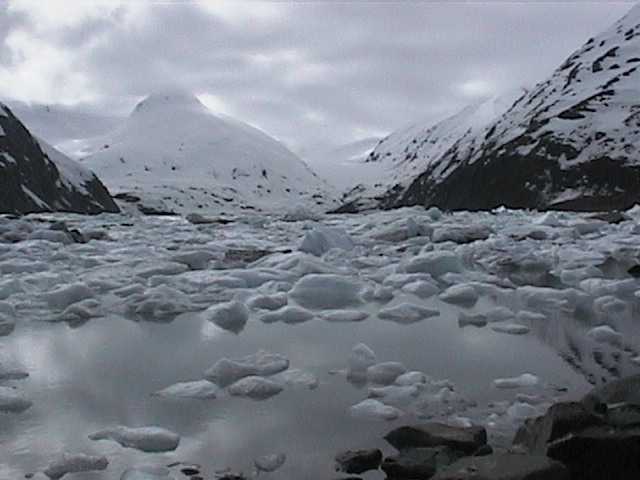
We spent most of the day today driving. We drove the 50 or so scenic miles north from Portage Glacier to Anchorage through a landscape of snow capped mountains flanked by beautiful ocean views of Cook Inlet. Yet once again, there were no whales breaking dramatically out of the water... In Anchorage, we stopped again at Carr's Groceries and picked up many of the same items that we got here several days ago. She came back out with the neat Alaska sweatshirts that we had eyeballed several days earlier as well as about 10 pounds of women's magazines (including People, Teen People, Vanity Fair and Cosmopolitan). This in depth reading material should suit her well while we are in America's pristine northern heartland.
My fare is no less for the proletariat. I have two sci-fi novels which I have been meaning to read for a long time: Jules Verne's "From the Earth to the Moon" and H. G. Wells' "The War of the Worlds". Then I have Tom Clancy's war of the worlds in the form of the thick "Red Storm Rising", which is still my favorite war novel and a damn good read for just about anyone interested in how things work in modern warfare. Interestingly, one of the points that the introduction to the Jules Verne novel brings out is that Jules Verne is the one who pioneered not only science fiction, but also the techno-novel in providing in depth details about how machines and technology worked. His predictions of travel to the moon are eerily prescient: Americans launch the first voyage to the moon; the launch site is the middle of Florida, etc. That was almost exactly 100 years before the real thing: 104 years to be exact, for he wrote it in 1865 while the actual Apollo 11 mission that landed Neil Armstrong and Buzz Aldrin on the moon was in 1969. He got a few of the details wrong, such as using a giant cannon for the launch - the acceleration forces of which would have easily extinguished life for any of the occupants, but now, 32 years after man landed on the moon, NASA is studying the possibility of using similar cannons! We also brought three books on tape: Call of the Wild, White Fang, and an F. Scott Fitzgerald snoozer which happened to be the only other half-way decent book on tape available at our Smyrna Public Library. But what we the best page-turner has been the poignant and relevant "Into the Wild", about a young man who trekked into Denali in the spring and died. Here we are nine years later at the same time of the year heading to Denali. More on "Into the Wild" later...
From Anchorage, we head north, still on Alaska 1, which is probably still officially the Seward Highway. All Alaska highways are numbered and named. The locals only use the names. Seward Highway connects Anchorage and Seward. The Parks Highway connects Anchorage and Denali and Fairbanks, but is actually named after a certain George Parks, and not because Denali sits on it. The Sterling Highway connects Homer to the Seward Highway at Moose Pass. And the rest also have such names. Most of the highways are one lane in each direction except for in cities such as Anchorage, with 250,000 souls where the highways grow to three lanes in either direction. The highway junctions seem to swell to maybe two lanes in either direction. But generally speaking, even in the towns such as Homer and Seward, it's just one lane either way. The tarmac is usually smooth looking like it has been refaced in the past ten years, but it never has that deep almost black look that the overdone highways of Atlanta always do. Alaskan highways are pocked by chuckholes, gravel breaks or expansion joints that weren't put in place by the builders. We also read that the snow removal machinery frequently removes a little more than just snow, which is another cause of the damage to the roads. Road shoulders are extremely limited in width decreasing the usual margin of error. On the other hand, it allows us to see moose grazing within ten feet of the road, apparently oblivious to passing vehicles, on three separate occasions.
We go through Anchorage and the limited access highway disappears abruptly in the city itself. And then we pick it up just as abruptly again on the eastern side of the city where it becomes the Glenn Highway. From Anchorage, we pass through a series of run of the mill towns that could be anywhere America. Eagle River is first. And then on to Wasilla, Houston (which I don't remember even noticing), Willow (ditto), Montana (ditto), Sunshine (ditto), Talkeetna (ditto again). In fact, the only town I remember noticing was Trapper Creek, where we had planned to dump our excess waste and take on new water. There were two gas stations; neither was the one that our guide booklet we had received in the mail before leaving Atlanta told us to expect. But based on the mile markers in the guide booklet and where we thought we were, we guessed that it was the Tesoro Gas Station we had passed a little while back. Unfortunately, the dump station at the Tesoro Gas station was still frozen, according to our gregarious hostess who never let her cigarette smoking get in the way of warmly greeting customers or sweeping the floor. She was very apologetic that we couldn't use the facilities and tried to find a way to give us some free water to make up for it. This kind of kindness is typical of just about everyone we met in Alaska. Regardless I would certainly recommend that people hit dump stations well before they plan to need them and also replenish at every opportunity even if it might slow down projected travel times.
I was tired, but we really had no choice since we absolutely had to have some more water and also a place to dump our waste. So we executed an ad hoc decision to drive the extra 70 miles beyond our projected end point in Denali State Park where we had planned to stay for one night and to continue on to the real thing: Denali National Park.
The drive was beautiful. Anchorage to Denali should be about a five hour drive, but I think that it took us about six with the turn around to head back for the gas station. Alaska around Denali is divided into two main types of surface layering. Taiga is basically what is below the tree line. Here you have the white cedars and the black cedars and all of the underbrush. Tundra is what is above the tree line, typically 2,000 to 3,800 feet depending on weather and winds. At first, from the distance, the tundra like huge fields or meadows that go on over the hills, which is a far difference from the flat endless wasteland of a tundra that I had always envisioned from the look of Dr. Zhivago and other movies as well as vestigial memories of living in Winnipeg from 6 months to four years of age. But on closer inspection, the great variety of colors that forms this micro system is more evident. There are blueberries, crowberries and cranberries, though we fail to recognize any such types of berries. We do see a good variety of lichens and of small plants that look like they are either optimized to let the high winds pass through them or designed to flex with the winds without being on the receiving end of too much abuse. We also see small shrub type bushes by the little creeks that have caterpillar like heads.
The railroad crosses the road from time to time, runs parallel at others and disappears completely the rest of the time. The roadbed sits on a mini-crestline that must have been laid out by engineers. The drive along this crest line affords scenic views to both right and left, but mostly to the left as we actually start to approach Denali.
At 7:30 pm or so, we finally make it to the entrance and then to the Visitor Center. The center is officially closed, but we decide to go in anyway, and find out that there is an employee party. We get information from the bookstore, and then head back to the RV site at the entrance.
May 24 - Denali
Our day is pretty slow. We drive to the Princess Lodge hotel opposite the entrance to the park and head up the long sinewy drive to actually go up the hill to actually get up there. The Princess Lodge Hotel feels more lodge than hotel, in spite of the uninspiring parking lot at the back. Walking inside, it feels very much the lodge. We're there for the breakfast buffet. It's our first meal out of the RV. The view from the restaurant is pleasantly commanding and we can see the George Parks Highway right below us. We grab a sumptuous buffet breakfast and are stuffed by the time we even start thinking about a second plate. Still, I grab a second plate and end up leaving needlessly full. We head back down the hill, cross the George Parks Highway, then drive on the park road past the Riley Creek dump station we tried to hit last night. It's probably still frozen solid. We then go further into the park. The road curves to the right (north) passing the visitor center as it climbs uphill and then eventually heads south again so that it winds between the Denali train station and runway to the right and the hotel and gas station to the left. There is a crowd gathering at the Denali train station. They are probably headed back to Seward. Princess Cruise Lines plies its trade up and down the inland passage threading through the islands that make up the southeastern panhandle of Alaska heading covering the Juneau, Misty Fjords, Glacier Bay area before heading to Seward. I don't know if all of the cruises do this since we didn't investigate the cruises. I hope to do that at some point, but for now that option was way off of the budget. Anyway, the cruise ships dock in Seward and then passengers disembark there, go to the train station there, and get shunted up to Anchorage and then eventually on to Denali. The track echoes the roads we have travelled and have even crossed it several times. The George Parks Highway was only built in 1972, so before that the railway would have been the way to come.
So near the train station, We fill the natural gas tank up for about $50. I fiddle a bit and finally have to get someone to help me figure out how to get the cap off.A nice lady, probably barely in her 50s, comes out to show me what to do to remove the cap. And I make sure I get it back on properly again since I don't want to blow up the RV by accident since that would be a bit embarrasing (and expensive enough to max out my credit card several times over), to say the least. I always wonder how people do all of this stuff in the winter. Right now the temperature is pleasant and I can do all of this kind of stuff without cold weather gloves on. We park behind the hotel, then eventually make the not too difficult yet still beautiful hike up to Mt. Healy.
The hike is short and easy with no real great drama in the climb. The view from the top is beautiful and the breeze is cool. We pose for a photo together in our matching Alaska sweatshirts. The Alaskan Range, of which Mount McKinley is the premier member, rises in the background. And I feel like we could stay up here for a long time. But we didn't. We headed back down like we were in a hurry to get somewhere. And now as I type this, I wonder why we didn't stay longer. Life is too short not to savor these kinds of places. I mean, after all, how often do we make these kinds of trips - not just to Alaska, but to the top of a mountain, even if this is a little one. What expensive in time and money have we used to get here only to turn right back around after a few minutes. No, these kinds of moments should be savored, taken in and really enjoyed.
Yet another night of staring out of the back window of the RV, waiting for the aurora borealis to show. It doesn't. At this point, we're gaining six minutes of daylight every day and will continue to do so until the summer solstice. So our chances decrease continuously while we're on this trip. It's not until later that we will figure out that the Aurora Borealis doesn't show at all during this time of year.
May 25 - Preparation Day
Denali National Park vaguely resembles a triangle with a base that runs from southwest to northeast and a top which points northwest. It's about 120 miles from one side to the other! Denali National Park's base is bounded by Alaska Highway 3 - the fittingly named George Parks Highway. The highway itself cuts straight through Denali State Park which lies at the base of Denali National Park. Not sure why they aren't just one park. But they probably started off as two separate entities that were not next to one another since I know that Denali National Park has grown over the years. And now they are probably kept separate for administrative convenience. The road into the park is basically a straight shot toward Mount McKinley which is located slightly southwest of the center of the park.
There is no way to cross by car and there is only one entrance for vehicles, and that entrance is on the east. This solitary road is paved for a short distance and then turns into a dirt and dust road the rest of the way as it reaches 85 to 90 miles to Wonder Lake and Kantishna. It's too early in the year for that portion of the park to be open, so for our purposes, the road only runs out to 58 miles to the Toklat River.
Today is a preparation day. We got up late as is becoming more and more routine now that we are adjusting to Alaska time rather than our own Eastern Standard Time. It's cold outside, perhaps somewhere in the low 40s. We feel it inside and the borders of all of the windows are misted up. It was sunny in spots, but that has been supplanted by faceless white clouds that blanket the sky. It's a good day to stay inside and do very little of anything other than sip hot chocolate and watch movies. Unfortunately, we have neither. The other RVs are still around as well, not moving; collectively we look like a pod of really lazy stubby white whales on jacks, hoping that the tide will come in perhaps.
At 10:30 am, after having been back to bed for a short morning nap, we drive to the Visitor Center to make reservations for tonight, back at Riley Creek Campground as well as for various shuttle buses and to confirm our reservations at Teklanika. Reservations at Riley are still unnecessary, we are told, contradicting what we were told last night by the camp host. We don't have time for anything else as the shuttle bus leaves in a few minutes. The buses are run of the mill Bluebird buses just like we rode in high school. These are painted white and skirted by a ranger green stripe along the bottom. Our driver looks like Ben Stein (of "Win Ben Stein's Money" and "Ferris Bueller" fame) except that he has a beard anchoring the southern portion of his face while his upper lip is shaved clean enough to reflect sunlight. He professes to know nothing about geology, but still manages to banter effectively about the abundant flora and not so abundant fauna. He sounds convincing to me. Are the animals hiding? There are 600 bears estimated to roam throughout the park, which seems like a lot until one considers that Denali's 6.2 million acres are spread over an area larger than New Hampshire in a park about half as big as Switzerland. There are several hundred moose (meese? :) ) and about 2,500 caribou and 347 elephants (not really). The Dall Sheep are too numerous to be counted according to Ben. He takes the two of us and four other passengers, an elderly couple and two guys from the army sporting crew cuts and here to hike, the 17 miles to the Savage River.
Alaska's vastness continues to amaze. And the statistics of size and those that confirm it goes on and on and on. For instance, in many cases, flying is the only way to get around. Juneau, the state capital and the second largest city of Alaska, is only accessible by boat and by aircraft. As far as I remember, there are no roads leading to it from any other city. With only 30,000 people, it must also be one of the smallest capitals in the nation. Alaska has six times more pilots and about fifteen times more aircraft per capita than the average for the rest of the nation. Towns like Homer on the Kenai Peninsula do have roads, but also have plenty of aircraft as well. Floatplanes appear to be just as popular as the garden variety land-bound ones. There are something like 500 airports and seaports in Alaska, according to my out of date 1990 fact book. I saw on a nice illustration that if Alaska were to be superimposed over the Lower 48 American states, then it would reach from Florida to California and up to the border of Canada. That's how big it is. Of course, that includes the Aleutian Islands as well as the panhandle or whatever it is called that includes Juneau and reaches back down south along the west flank of Canada in the direction of Washington State.
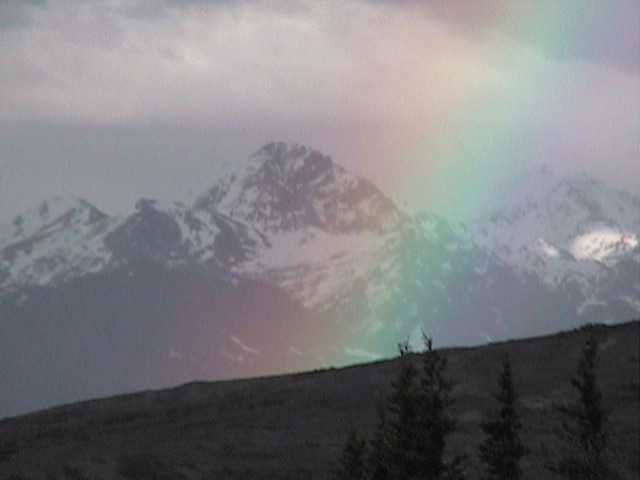
In the evening, we go searching out a dump station again. We had been told that the station at Riley Campground was out of commission, but thought that they were exaggerating. This afternoon, when we went to look, we saw three sturdy looking men toiling with a backhoe and the ground literally torn up to about five feet in depth. "Burst pipe," one of them explained. He came over and told us to go north 8 miles to Healy to Denali RV.
We did. We tanked up on potable water, then drove 100 feet to dump our gray water and sewage. My fingers just about froze in this cold temperature combined with winds that could fell a moose, or at least a tiny moose, or maybe just a bag of potato chips, but it really was windy!
That got me thinking about how I would improve these RVs and their facilities. First things first! Increase the size of the holding tanks for both fresh and waste water. I would probably double them since we keep running out of fresh water so quickly and room to store the gray and black water a little too quickly as well. Make the fluid and natural gas level indicators more graduated. And increase the knee room for the toilet since mine practically bump into the wall separating the bathroom from the bedroom. Improve the aerodynamics. There are plenty of other tweaks that I would recommend, but these are the only functional ones that I can think of right now. On the wish list, I would add window shades that could be lowered from the top and raised from the bottom to meet half way. This would give occupants the ability to keep the top part of windows open for the view and the bottom part closed for increased privacy. I would also change the decor completely, but that's been addressed elsewhere in this masterpiece of travel literature destined to enter the annals of Americana :). I would also add a good trip computer, especially one that had an exterior temperature gauge, barometer, and compass. Probably the high-line models already have these, but this kind of stuff has become inexpensive enough to be mundane.
We grab the bus to Savage River. Like all of the other buses and all of the other tours into the park, it takes the same dirt road, kicking up a cloud of dust behind it, and stops at the same places - a vehicular freestyle of sorts. Those same places are any place the bus driver or the passengers find interesting. See a moose? Stop. See an elk? Stop. See a bear? STOP! Everyone rushes to the side of the bus closest to the animal(s) and takes photos. I assume we'll tip over sideways at some point, but it hasn't happened yet. The animals all have fur that compliments mother nature in some way. And often they are probably right in front of us some place, but camoflaged away. Movement helps: when they move, we stand a better chance of seeing them. The marvelous thing about Denali is that the animals are all wild. It may seem like they are tame in some ways, but they aren't.
Changes in lighting change the mood immediately. When the sun is out, we see all kinds of warm, upbeat hues that are golden, tan or brown framed or spotted with white snow. When the clouds cover up the sun, then the world turns into a black and white photo with the various warm hues turning into black. The white snow stands in great contrast then.
The river meanders along side the road at one point and the scenery just gets more and more spectacular. Small sand bars split the river into ribbons. Life is good. And everyone on the bus is in a great mood. And while all 30 or 40 of us are all together, we are alone out of sight of anyone else. The moutains on both sides are both vast and intimate at the same time. Sometimes we are right on top of them and sometimes they are off in the distance. For some reason, the mountains are far less covered with snow then they were around Portage Glacier where it was lower in altitude. The mountains roll gently in many places, like exaggerated treeless versions of the Appalachians. And in other places, their sharp and jagged rocks are exposed with brutal abruptness as if they have never felt the wind or the rain on them. Ansel Adams spent years photographing mountains writing "No matter how sophisticated you may be, a large granite mountain cannot be denied - it speaks in silence to the very core of your being." And so they do, their beauty and grandeur reminding us of how small our own buildings are in comparison and perhaps how transient we are in comparison to them.
A mountain goat stands - a solitary spirit alone for miles (other than us) - in the distance, his fur the perfect off white color that makes it look like a rock face. Standing just tall enough to nurse underneath is a baby. The bus stopped at Savage River. We got out and took photos. Everyone got back on board and then we headed back to where we had picked up the bus in the first place and then got back in the RV. Later another mountain goat walks fearlessly along the crest of a hill, his ram curled back in classic style. Certainly he must know that he is very visible against the sky? Then again, he can see down both sides of the hill at once and thus can avoid surprises. Maybe that's why he does it that way.
With the camp ground closed and out of commission and with no other place to go, we listened to the workers, headed back out of the park, then turned left to head to Healy. The drive up is beautiful - a small serpentine stretch with a nice vertical rise off to the right (east). We followed the contours of the road though the RV is no sporting machine. And we ended up at Denali RV. After sleeping in Seward, at Ninilchik and also at Portage Glacier, this camp ground was visually minimalistic. In fact, it was a shame that we didn't have the stunning scenery that we had gotten used to so quickly. But there were full hookups, and so we parked the RV, opened the water door and power doors and plugged in the water and electricity. No having to run the loud generator tonight. There were only a few other RVs there though the lot was quite large, unrolled across a flat treeless expanse, so I imagine that it fills up quickly starting in a few days or perhaps another week or two at most.
After dinner, I spent time working on this travelogue and then reading my books before going to the back of the RV to bed.
May 26 at Denali National Park
Today we started out at Denali RV. The day was young and we were very excited to be heading to Teklanika - the camp ground we had made prior arrangements for which represents the furthest that one may drive onself by RV or any other type of private vehicle.
We have a special three day pass to park our RV at Teklanika Camp Ground - a tent/RV ground. The rule is that we can drive in, park for three days without moving at all, and then drive out. Or so the rangers tell us. And our ticket says the same thing to effect: "Permit valid for one vehicle. ONE TRIP IN AND OUT ONLY" - spelled out emphatically in capital letters just like that. No extensions of any kind are offered, there is a finite number of spots and at any other time of the year into the summer months, there would probably be a long waiting line to get one of the spots. And moving the RV can only be done when leaving. We drive in the 29 miles into the park, find a nice spot and then park the RV. There is a bus leaving not too long later, and so we board it.
Our bus picks us up at the campground and we board along with a few others. Destination: Toklat River.
The bus is a standard school bus, like the kind made by Bluebird. Heck it probably is a Blue Bird. But it's painted green and white. I feel like I'm back in school with a bunch of adults. And the bus driver is the youngest person aboard. The road curves every which way and we go from one side of the bus to the other to view whatever is being called out by the bus driver or passengers.
We pass by the same places we saw yesterday. The scenery is becoming familiar and comfortable. But it still impresses endlessly.
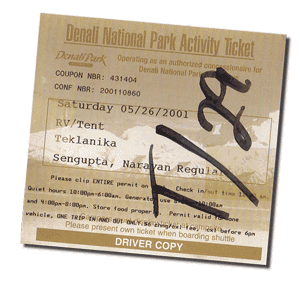
Toklat River photos.
We get back at "night". It's not, for it's still completely Alaskan summer bright outside, but our bodies feel tired from having been sight-seeing all day. We sweep through dinner and then I'm wired. I always get my second wind once I have had a bit of time to relax and decompress from the day's events.
I had mentioned the 1996 book "Into the Wild", by Jon Krakauer, earlier in this travelogue. I am almost finished with it and finish it later this night. "Into the Wild" is about an idealistic, well educated and very intelligent young man - or a boy, really - named Chris McCandless. He was an Emory student two years my junior, whom I vaguely remember meeting a couple of times while I was in the publications staff while I was a student at Emory. I graduated in 1988; he graduated in 1990. Chris inherited $25,000, referred to himself as Alexander Supertramp, then spent two years in perambulatory journey that saw him work odd jobs in a long arc that took him from Atlanta to Midwestern and Southwestern US and then up via Dawson Creek, Canada to Alaska. He had already donated the main bulk of his $25,000 to others. It was here that he hitch-hiked to Denali in April of 1992, where he was dropped off just north of us along the George Parks Highway and then he hiked in north of the park road. Armed with a shotgun and a 10-pound bag of rice determined to somehow live off the land by himself; his pioneer spirit and enthusiasm were strong. I admire his sense of adventure, for I too would have loved the idea of doing something like that. He crossed a small creek as he hiked into the park. He used an abandoned bus - Fairbanks Bus 142, which hunters had used from time to time, as a home base. He would spend time every day hunting or foraging. Squirrels, grouse, duck, porcupines and other animals became his prey and then his dinner. He also ate mushrooms and various types of berries. And even read and highlighted a copy of Doctor Zhivago. The July summer heat had started melting the snow which turned the easily crossed creek into the on-rushing Teklanika River - the same river we are parked near to in our RV at Teklanika Campground. McCandless was cut off from getting back to the George Parks Highway before he came to the realization that he wasn't going to be succesful in the Alaskan wilderness. Chris had hiked south along the river trying to cross over it either on foot or by bridge since he could then have hiked to the road to be rescued. He lacked a good map. The maps show us that had he hiked north along the river, he would have found a bridge about half a mile north of the bus and could have crossed over safely. Amazingly, he managed to survive by himself for 119 days, before starving to death. They found his body and his journal in the bus. Six miles south of his location was a National Park Service emergency cabin stocked with food and bedding. That too would have saved him had he known it was there. All this for want of a $10 map. This was in 1992. The bus was 30 miles away from the George Parks Highway and 16 miles north of the road that enters the park. We were 29 miles into the park along the same road, so the bus must have been about 16 miles north of our campground. And so there you have it: the poor kid had starved to death 16 miles away from where I was finishing the book.
[Note: as of 2007, I have read the book twice. And every time I think of Alaska, I usually think of him. To this day, my heart goes out to Chris McCandless' family and to all of those who loved him - for according to Jon Krakauer's fascinating book, there were many. It is tempting to castigate him for his oversight. And yet to me it underlined how often susceptible we are to making even the tiniest mistakes, no matter how well prepared or well intentioned we might be, which can be life changing or fatal.]
May 27
Woke up late enough to miss our 7:45 am bus that would have come through our campground about an hour later. Instead, we caught a green bus at about 10:45. Teklanika is at mile 29, but our destination was anywhere around Polychrome where we could get out and hike a bit. That's the way it works in Denali: buy a ticket for a bus trip, but then get off wherever you want just by asking the driver.
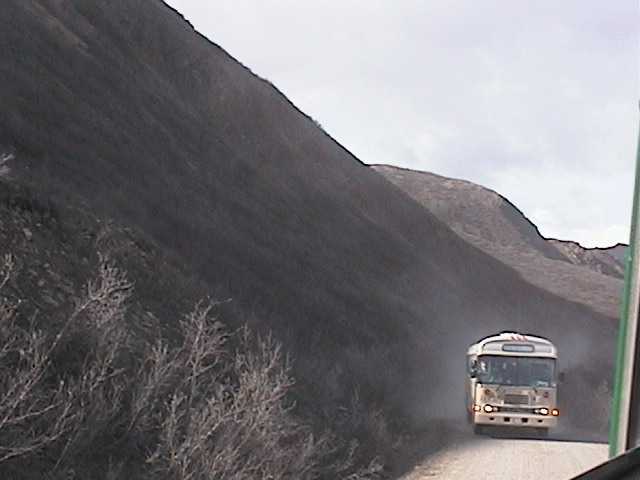
And we did just that. Annette, our good natured and informative bus driver dropped us off right where the unfinished dirt road bottoms out about 50 feet above the valley floor. From there, we hiked out a mile through the scrub brush to the little foothills sprinkled with snow. I thought it was a lot of fun to be out there in the middle of nowhere and yet still know that we weren't. So I figured the chances of a bear encounter were rather slim. But the nice thing was we couldn't see the road. We could see where it cut along the side of the hill only because a bus would go by every once in a while. I wish I had taken a good book that I could have read. We sat there for a while and soaked in what we didn't at Mount Healy. The sunshine was perfect - not too hot. The lighting was golden across the valley floor in front of us.
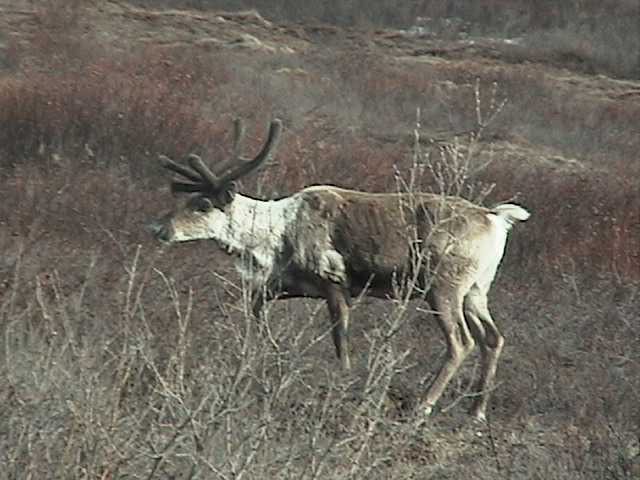
We spend 3 hours out there total waiting for the bus. I am analytical. It's not like the buses won't come this way. After all, once they go to the center of the park, there is only one way back out and that's along this one solitary road. She decided that she wouldn't wait, took off and walked west to the next official bus stop while I build rock dams in the stream right where it goes underneath the road. Then I take bus the other way to the far end of the park because I don't want to not have a chance to get on a bus and be stuck out here at night since buses that are full will not stop to pick up those waiting. Later the bus turns away other hikers trying to get on. He tells them to wait for the next bus, but each bus that we have been passing that is behind us is full! I spot mother grizzly and her cub and again a mother and cub (probably the same one) and then again another bear standing up! By the time we get back to our RV ground, we're too tired of roughing it to stay at Tek. We are prepaid for another night at our camp ground, but we're fidgety and not all that thrilled with the camp ground. So we decide to leave the park one day early and head back to Denali RV, just outside the park, a few miles north of the park road and the entrance. And we know that there we will have full hookups. On our way out, we see a grizzly and cub off to left just 30 feet away!
We see other animals on our day trip including a fox, some mountain goats (or were they sheep? I always confuse the two when I don't see horns or a lot of fur.)
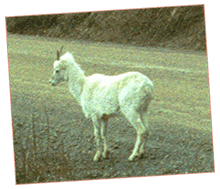
May 28
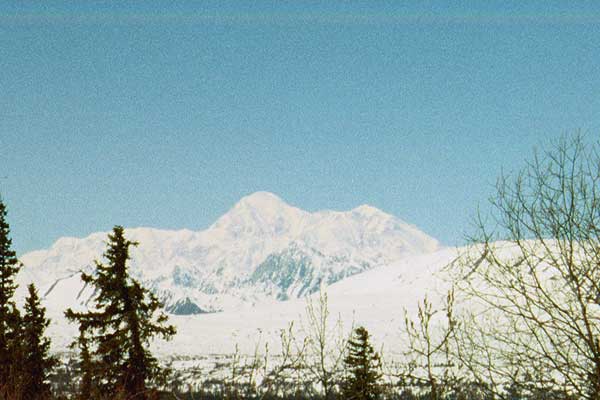
It is only when we leave the park that we see the great 20,320 foot tall Denali (Mount McKinley), the tallest mountain in North America. But we're not alone. The official statistics are that something like only five percent of visitors to Denali National Park ever see the top of the mountain. It's only when we leave Denali National Park and head south to Denali State Park that we actually see the top of the mountain. The view is astounding. The mountain feels like it's practically right on top of us. We marvel for just a few minutes since we have to get back to Anchorage in time to drop the RV off after cleaning it up.
We finally get back into Anchorage. And now we have to find a dump station for we are supposed to return the RV cleaned up and cleaned out or face fines. We have a map of dump stations, and so we finally find one and I get to do my least favorite chore yet once again. We also top off the gasoline.
There is no one to check us in at Sweat Retreat RV so we leave the keys in the drop and head out hoping that we won't get some surprise fees/fines when we get back to Atlanta. We have an Albanian/Yugoslavian driver from Alaska Cab. He's fun to speak to and informs us that John Belushi was of Albanian descent. Personally I found that pretty interesting. Next we got to the airport and caught our flight.
May 29
It's about 4 am Atlanta time, midnight Anchorage time. We've been on the plane for about four hours now. Meal was lousy, as usual, but the movie was "Chocolat" starring Juliette Binoche and Johnny Depp.
We can't wait to get back and to see the cats and the family.
The battery of this laptop is probably going to die very soon, so I'm being brief as I have to recap the last several days, and I haven't started yet. So I will after I finish this sentence.
Expense Log
I have added this in case anyone reading this wants to get an idea of what typical expenses may be like. In general, food is more expensive then at home. But other than that, things weren't that bad. And I think that we saved a bundle by renting the RV and preparing our food in it. Plus the convenience of the RV - of sleeping whereever, of not having to check in, unpack, pack, check out every day on this kind of trip, was phenomenal.
Pre arrival:
- $400 Deposit for RV Rental
- $20 Books
- $900 Camcorder + extra battery
- $50 Mini DV tapes
- $100 Backpack, little bag, misc. supplies
- $220 Major Marine tour for two in Seward including lunch buffet
- $40 Denali (3 nights camping + $4 reservation fee)
- $0 Plane ticket (using Delta SkyMiles).
- $330 28-300 mm lens for Sigma SA-300 camera
May 18
- $0 Parking b/c since we got a ride from my father
- $5 Very little food at airport because we ate before leaving.
- $15 Taxi in Anchorage from airport to Sweet Retreat RV Rentals.
May 19
- $1069 RV Rental
- $130 groceries, socks, underwear, shorts, 2 bug sprays, etc.
- $10 Subway sandwiches
- $40 Tripod from Kmart
- $40 Wal-Mart (Watch and something else for about $8)
- $120 Carr's Groceries
- $40 Carr's (Wine and Champagne)
- $10 Parking in Seward
May 20
- $10 Parking in Seward
- -$60 Credit for Major Marine tour being cut short
- $1 Post cards
May 21
- $10 RV Camping fee at Ninilchik State Park (and that's the only thing we paid today!)
May 22
- $10 RV Camping fee at Portage Glacier
- $79 Gas and propane
- $130 Groceries
May 23
- $0 RV Camping fee at Denali NP-Riley Creek
- $50 2 Tickets on Portage Glacier Ferry
- $85 Gas
- $100 Groceries from Carr's including 2 sweatshirts and 4 magazines
- $14 Books from Denali Visitor Center
May 24
- $0 RV Camping fee at Denali NP-Riley Creek
- $26 Brunch at the Princess Lodge just outside of Denali
- $50 Natural gas
May 25
- $10 RV Camping fee at Denali NP-Riley Creek
May 26
- $75 Gas
- $10 Misc. magazines for wife letting us keep up with latest Brad/Jen news
- $0 RV Camping fee at Denali NP-Teklanika already pre-paid
May 27
- $0 RV Camping fee at Denali NP-Teklanika already pre-paid
- $17 RV Camping fee at Denali RV since we didn't want to stay at Teklanika
May 28
- $-400 Refund of RV deposit
- $47 Gas
- $15 Taxi ride back to airport
- $18 Food at airport
May 29
- $0 Ride from my father from airport back home
Some notes from 2007
PS: Since writing this, Sweet Retreat RV Rentals sadly appears to have gone out of business. NS.

 Home
Home
 USA
USA